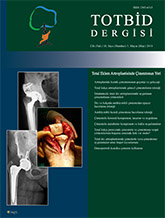
Total knee arthroplasty surgery has been successfully applied for many years in the end-stage treatment of patients with last stage knee arthritis (gonarthrosis). A number of cementing methods have been used to increase prosthesis survival, success of the surgery, and for the strong fixation of components. Over the years, the methods and techniques of cementing have shown technological improvements and changes. However, optimum technique of cementing is still controversial among total knee arthroplasty surgeons. Cementation technique, amount of cement applied, depth of cement penetration, and bone surface preparations made before application depend on the preferences of the surgeon, and therefore, show a wide range of variation. As a result of many clinical and experimental studies, many techniques have been proposed and conflicting outcomes observed. As a general view: careful preparation of the bone surface and adequate cement penetration are important parameters for component fixation. Inefficiencies in the early implant fixation lead to aseptic loosening, which is the most important and frequent cause of primary total knee arthroplasty failure. In this review article, we aimed to evaluate the current cementing methods applied by examining the clinical and experimental results of current cementing applications and techniques. We evaluated the results of bone surface preparation, fixation enhancing methods, cement application and ease of application for tibial and femoral component fixation in total knee arthroplasty, in the context of current literature.